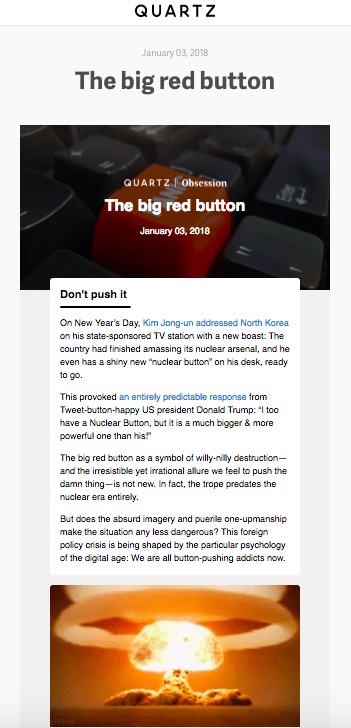Since Sept. 18, Quartz has sent a global daily Quartz Obsession newsletter arriving at 4 p.m. in each local time zone. The newsletter features content snippets like charts, statistics, videos cards, text, quizzes, quotes, timelines or polls so that readers can either dive into or scan the topic.
While the Quartz Daily Brief morning newsletter aims to bring the publisher’s business-focused audience around 20 important stories from around the web to set them up for the day, the afternoon Obsession newsletter gives people more time to go deep on a particular niche area, according to Jessanne Collins, editor of Quartz Obsession.
“There’s a sense of news-cycle fatigue, which can offer an important gap for media products to fill,” she said. “There’s a hunger for smart, relevant, interesting coverage that’s not regurgitated and not the same news day today.”
Quartz doubled the number of subscribers to its newsletters, which include its Daily Brief and pop-up newsletters tied to global business events, last year to over 700,000. The publisher wouldn’t share how many people subscribe to Obsession, but it said the open rate is over 78 percent, much higher than the average open rate for media newsletters, which is about 22 percent, according to MailChimp.
While there’s a seemingly unlimited number of potential topics that Obsession could focus on, the task is finding the right level of specificity. The topic needs to balance breadth and giving readers a good picture of the story, rather than subjects that are too general like World War II or the Industrial Revolution, according to Collins. Quartz groups its coverage into “obsessions,” an evolving list of global issues that affect the economy. Collins added that the email is a natural extension of Quartz newsroom coverage on these topics.
The team takes inspiration from the day’s news to single out which topics to focus on in the newsletter. For example, North Korean leader Kim Jong Un’s address on New Year’s Day sparked an Obsession email about the “nuclear button” and how the symbol has been used in history and politics. It’s a dense topic, but it has the scope to be covered from both a narrow and wide enough perspective to warrant an Obsession email. The newsletter is also customized by location, and reporters from across the world take turns writing it, with the newsletter adopting a different byline each day.

“We introduced the email to editorial as a new format for them to experiment with. There’s a lot more product capability and experimentation to come,” said Eva Scazzero, associate product manager at Quartz. “With each part of the story, we think about how it can be anything other than text and do as many of those as possible. You can convey a lot of information in a quick factoid. We want to put the maximum amount of information in a minimum amount of space.”
Obsession has collected reader responses for a month, whether that’s asking readers for their favorite mezcal recipes or what topics Quartz should feature, helping to build a community mentality around the newsletter, according to the publisher. Polls are often whimsical and irreverent, like “tell us about an encounter you had with an eel,” or “what’s the last great idea you had in the shower?”
“Interactivity is core to the email. We want to get deeper into reader suggestions of topics,” Collins said. “It’s reflected in the scope of what we cover and that feedback loop.”
Hewlett Packard Enterprise, Samsung and education technology company 2U have also sponsored Obsession emails, although the publisher couldn’t go into detail about its clients’ campaigns.
For all of publishers’ interest in launching more newsletters to engage directly with readers, an ongoing problem is tracking and measurement. Gauging success is variable and often depends on the publisher’s numbers rather than a third-party auditor.
“The forwarding email click-through rates [for Obsession] are really high. It’s a clear indication that it’s working,” said Scazzero in response to which topics have been the most popular, “the topics are so different it’s difficult to understand what’s affecting that behavior — whether it’s the day of the week, the topic, the placement of the links — so it’s difficult to feel good about that number.”
More in Media

YouTube is under fire again, this time over child protection
Adalytics Research asks, ‘Are YouTube advertisers inadvertently harvesting data from millions of children?’

Media Briefing: Publishers pump up per-subscriber revenue amid ad revenue declines
Publishers’ Q2 earnings reveal digital advertising is still in a tight spot, but digital subscriptions are picking up steam.

Lessons for AI from the ad-tech era: ‘We’re living in a memory-less world’
Experts reflect how the failures of social media and online advertising can help the industry improve the next era of innovation.
Ad position: web_bfu



